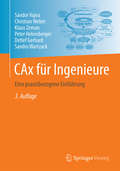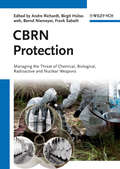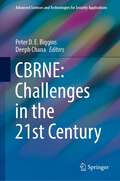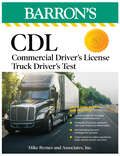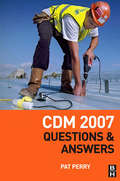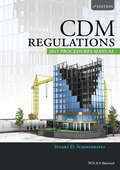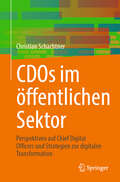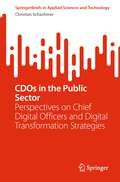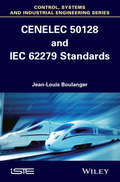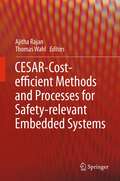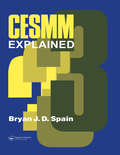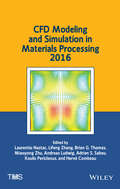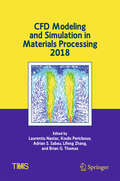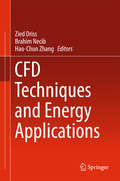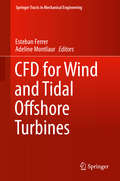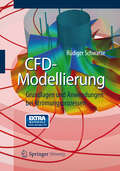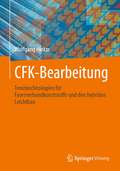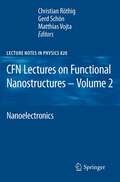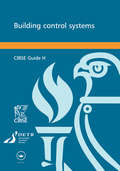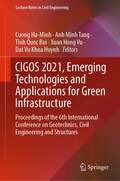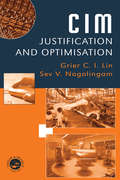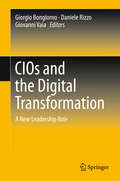- Table View
- List View
CAx für Ingenieure: Eine praxisbezogene Einführung
by Peter Hehenberger Sándor Vajna Christian Weber Detlef Gerhard Klaus Zeman Sandro WartzackDieses nun in der dritten Auflage erschienene Buch vermittelt die Grundlagen des systematischen Einsatzes von rechnerunterstützten Methoden, Vorgehensweisen und Werkzeugen in der Produktentstehung. Es bietet seinen Zielgruppen in knapper und übersichtlicher Form das Rüstzeug für die erfolgreiche Anwendung von CAx-Systemen. Vorgehensweisen und Beispiele basieren auf Erfahrungen in Industrie und Hochschulpraxis, wo sie ihre Effizienz bewiesen haben.Die 3. Auflage wurde gründlich überarbeitet, der Kreis der Autoren erweitert. So kamen nicht nur Aspekte unterschiedlicher Modellierungsarten, Mechatronik und Wissensverarbeitung hinzu, sondern auch Ausführungen zu Systembegriff und Modellaufbau (diese bilden die Basis für CAx-Anwendungen). Sie alle beeinflussen immer stärker die Fertigungstechnik und den modernen Fahrzeug-, Maschinen- und Anlagenbau und sie spannen den Bogen zur Systemtechnik. Neben dem aktuellen und zukünftigen Leistungsstand von CAx-Systemen wurden auch Richtlinien und Empfehlungen zum Stand der Technik berücksichtigt.ZielgruppenDas Buch eignet sich für Studierende der Ingenieurwissenschaften, für Fachleute in Unternehmen sowie für Führungskräfte, die über Einsatz und Ausbau von CAx-Anwendungen entscheiden.
CBRN Protection
by Frank Sabath Andre Richardt Bernd Niemeyer Birgit HülsewehOriginating in the armed forces of the early 20th century, weapons based on chemical, biological or nuclear agents have become an everpresent threat that has not vanished after the end of the cold war. Since the technology to produce these agents is nowadays available tomany countries and organizations, including those with terrorist aims, civil authorities across the world need to prepare against incidents involving these agents and train their personnel accordingly.As an introductory text on NBC CBRN weapons and agents, this book leads the reader from the scientific basics to the current threats and strategies to prepare against them. After an introductory part on the history of NBC CBRN weapons and their international control, the three classes of nuclear/radiological, biological, and chemical weapons are introduced, focusing on agents and delivery vehicles. Current methodsfor the rapid detection of NBC CBRN agents are introduced, and the principles of physical protection of humans and structures are explained.The final parts addresses more general issues of risk management, preparedness and response management, as the set of tools that authorities and civil services will be needed in a future CBRN scenario as well as the likely future scenarios that authorities and civil services will be faced with in the coming years.This book is a must-have for Health Officers, Public Health Agencies, and Military Authorities.
CBRNE: Challenges in the 21st Century (Advanced Sciences and Technologies for Security Applications)
by Peter D. E. Biggins Deeph ChanaThis book addresses the pertinent issues that will need to be considered by those interested in physical security problems of the future. Specifically, it examines how changes in the accessibility of technology – data, hardware, software – are likely to affect both threat and mitigation considerations for Chemical, Biological, Radiological and Explosive (CBRE) scenarios and how social science can inform us of the human aspects of each. The trend towards an ever more socio-technical society and infrastructures – encapsulated by concepts such as 'smart cities' – is drawn out as a key motivation for adopting more holistic risk approaches to such security problems, than is currently the case.
CCNA 200-301 Portable Command Guide
by Scott EmpsonCCNA 200-301 Portable Command Guide is filled with valuable, easy-to-access information–and it’s portable enough to use whether you’re in the server room or the equipment closet. <P><P> The guide summarizes all CCNA certification-level Cisco IOS Software commands, keywords, command arguments, and associated prompts, providing you with tips and examples of how to apply the commands to real-world scenarios. Throughout, configuration examples give you a better understanding of how these commands are used in simple network designs. <P><P> This book has been completely updated to cover topics in the new 200-301 exam. Use this quick reference resource to help you memorize commands and concepts as you work to pass the CCNA certification exam. Coverage includes
CDL: Commercial Driver's License Truck Driver's Test, Fifth Edition: Comprehensive Subject Review + Practice (Barron's Test Prep)
by Mike Byrnes and Associates,Be prepared for exam day with Barron&’s. Trusted content from CDL experts!Barron&’s CDL: Commercial Driver&’s License Truck Driver&’s Test includes in-depth content review and practice. It&’s the only book you&’ll need to be prepared for exam day.Written by Experienced EducatorsLearn from Barron&’s--all content is written and reviewed by CDL expertsBuild your understanding with comprehensive review tailored to the most recent written and driving testsGet a leg up with tips, strategies, and study advice for exam day--it&’s like having a trusted tutor by your sideBe Confident on Exam DaySharpen your test-taking skills with 2 sample Knowledge Tests, a diagnostic test for assessing strengths and areas for improvement, and practice for the Skills TestStrengthen your knowledge with in-depth review covering all topics CDL drivers need to know, including federal motor carrier safety regulations, basic vehicle control, vehicle inspection, and much moreReinforce your learning with hundreds of practice questions covering all tested topicsDeepen your understanding with expert advice about commercial driver licensing, dozens of detailed diagrams that demonstrate proper driving procedures, and a series of appendices with state-specific transportation resources
CDM 2007
by Pat PerryThe Construction (Design and Management) Regulations 2007 repeal the CDM Regulations 1994 and the Construction (Health, Safety and Welfare) Regulations 1996; containing all the legal duties regarding the design and management of a construction project and the safe operating standards expected on a construction site. CDM 2007: Questions and Answers by Pat Perry is a pragmatic, common-sense approach to interpreting the many queries which will inevitably arise from the new Regulations, no matter how simplified they purport to be. The author details practical solutions to a wide range of legal compliance issues and explores answers which go beyond the rather limited information contained in the Approved Code of Practice which supports the Regulations. The various duty holders, project stages and safety issues are dealt with in different chapters and the book can be used for detailed reference or for a quick refresher on specific subjects.
CDM 2015: A Practical Guide for Architects and Designers
by Paul BusseyThis is the designer’s essential guide to implementing the new CDM 2015 regulations. It provides both a straightforward overview of the key changes and new duty holders, including the Principal Designer, as well as full colour diagrams and annotated plans which demonstrate how to apply the principles in the real world. As the regulations come into force it aims to reassure those fearing a change in their obligations by outlining easy to use practical tools which will integrate the philosophy of the new regulations – of proportionate response, creative solutions and collaborative working – into day-to-day practice. It’s designed as a concise and handy quick reference guide, easy to carry around on site or use at your desk, translating what can be dry and often impenetrable legislation into a set of simple, intuitive, design friendly and safe messages.
CDM Regulations 2015 Procedures Manual
by Stuart D. SummerhayesThe CDM Regulations require all those involved in construction to adopt an integrated approach to health and safety management. This Procedures Manual provides a documentation system for compliance with the statutory requirements. It is being thoroughly revised to take account of major changes to the CDM Regulations 2015.
CDOs im öffentlichen Sektor: Perspektiven auf Chief Digital Officers und Strategien zur digitalen Transformation
by Christian SchachtnerDieses Buch untersucht die Notwendigkeit innovativer Ansätze zur Administrationsdigitalisierung, indem Technologien wie KI, Blockchain und intelligente Prozesse genutzt werden, um den Erwartungen der Bürger gerecht zu werden. Besonderes Augenmerk liegt auf der Rolle der Chief Digital Officers (CDOs) bei der erfolgreichen digitalen Transformation innerhalb öffentlicher Institutionen. Die digitale Verwaltung erfordert frische Impulse, um mit den Fortschritten im Industriesektor Schritt zu halten, indem Technologien wie KI-gesteuerte Automatisierung, Blockchain-Transaktionen und Sicherheitswerkzeuge eingesetzt werden. Intelligente Prozesslösungen werden als transformativ angesehen, um die Service-Standards gemäß den Erwartungen der Bürger an den Staat aufrechtzuerhalten. Im Gegensatz zu kommerziellen Unternehmen bietet die Zusammenarbeit denjenigen, die die Digitalisierung im öffentlichen Sektor überwachen, erweiterte Skalierungsmöglichkeiten, indem sie auf Erfahrungen aus anderen Regionen und Metropolen zurückgreifen, die direkt anwendbar und wiederverwendbar sind. Im öffentlichen Bereich spiegeln digitale Strategien rechtliche und soziale Bedingungen wider, was Anpassungen und Anpassungsoptionen für Chief Digital Officers erforderlich macht, während sie die digitale Transformation leiten. Methodische Schwerpunkte in der Neugestaltung von Aufgabenstrukturen, Prozessoptimierung und der Motivation von Akteuren ergeben vielfältige Handlungsfelder für die neue Rolle des CDO in öffentlichen Institutionen. Dieses Buch untersucht die Instrumente, Strategien und Einstellungen, die notwendig sind, um transformative Initiativen in Organisationen erfolgreich umzusetzen, und betont bewährte Konzepte mit praktischer Anwendbarkeit, die es den Lesern ermöglichen, ihre eigenen Interaktionsmöglichkeiten als digitale Führungspersönlichkeiten abzuleiten. Das Buch ist eine prägnante Einführung in die spezifischen Anforderungen an visionäre Gestalter, die dynamische Veränderungen in nutzerzentrierten öffentlichen Dienstleistungen vorantreiben.
CDOs in the Public Sector: Perspectives on Chief Digital Officers and Digital Transformation Strategies (SpringerBriefs in Applied Sciences and Technology)
by Christian SchachtnerThis book explores the need for innovative approaches to administrative digitization, leveraging technologies such as AI, blockchain, and smart processes to meet citizens' expectations, with a particular focus on the role of Chief Digital Officers (CDOs) in driving successful digital transformations within public institutions. Administrative digitization requires fresh inputs to match the leaps seen in the industry sector, utilizing technologies like AI-driven automation, blockchain transactions, and security tools. Smart process solutions are seen as transformative in upholding service standards aligned with citizens' state expectations. Unlike commercial companies, collaboration offers those overseeing public sector digitization enhanced scaling opportunities by drawing from experiences in other regions and metropolises, directly applicable and reusable. In the public realm, digital strategies mirror legal and social conditions, necessitating adjustments and adaptation options for Chief Digital Officers as they lead digital transformation. Methodological focal points in task structure redesign, process optimization, and motivating actors yield diverse action areas for the CDO's new role in public institutions. This book explores the instruments, strategies, and attitudes necessary to successfully implement transformative initiatives in organizations, emphasizing proven concepts with practical applicability, enabling readers to derive their own interaction options as digital guidance leaders. The book is a concise introduction to the specific requirements for visionary designers driving dynamic changes in user-centric public services.
CENELEC 50128 and IEC 62279 Standards
by Jean-Louis BoulangerCENELEC EN 50128 and IEC 62279 standards are applicable to the performance of software in the railway sector. The 2011 version of the 50128 standard firms up the techniques and methods to be implemented. This is a guide to its implementation, in order to understand the foundations of the standard and how it impacts on the activities to be undertaken, helping towards better a preparation for the independent evaluation phase, which is mandatory.
CESAR - Cost-efficient Methods and Processes for Safety-relevant Embedded Systems
by Ajitha Rajan Thomas WahlThe book summarizes the findings and contributions of the European ARTEMIS project, CESAR, for improving and enabling interoperability of methods, tools, and processes to meet the demands in embedded systems development across four domains - avionics, automotive, automation, and rail. The contributions give insight to an improved engineering and safety process life-cycle for the development of safety critical systems. They present new concept of engineering tools integration platform to improve the development of safety critical embedded systems and illustrate capacity of this framework for end-user instantiation to specific domain needs and processes. They also advance state-of-the-art in component-based development as well as component and system validation and verification, with tool support. And finally they describe industry relevant evaluated processes and methods especially designed for the embedded systems sector as well as easy adoptable common interoperability principles for software tool integration.
CESMM 3 Explained (Spon's Price Books)
by Bryan SpainCESSM 3 Explained provides a detailed and highly illustrated guide to the use of the new civil engineering standard methods of measurements.
CFD Modeling and Simulation in Materials Processing
by Herve Combeau Miaoyong Zhu Adrian S. Sabau Lifeng Zhang Brian G. Thomas Koulis Pericleous Laurentiu Nastac Andreas LudwigThis collection explores computational fluid dynamics (CFD) modeling and simulation of engineering processes, with contributions from researchers and engineers involved in the modeling of multiscale and multiphase phenomena in material processing systems. The papers cover the following processes: Iron and Steelmaking (Tundish, Casting, Converter, Blast Furnace); Microstructure Evolution; Casting with External Field Interaction; and Smelting, Degassing, Ladle Processing, Mechanical Mixing, and Ingot Casting. The collection also covers applications of CFD to engineering processes, and demonstrates how CFD can help scientists and engineers to better understand the fundamentals of engineering processes.
CFD Modeling and Simulation in Materials Processing 2018 (The Minerals, Metals & Materials Series)
by Adrian S. Sabau Lifeng Zhang Brian G. Thomas Koulis Pericleous Laurentiu NastacThis collection presents contributions on computational fluid dynamics (CFD) modeling and simulation of engineering processes from researchers and engineers involved in the modeling of multiscale and multiphase phenomena in material processing systems. The following processes are covered: Additive Manufacturing (Selective Laser Melting and Laser Powder Bed Fusion); Ironmaking and Steelmaking (Ladle Metallurgical Furnace, EAF, Continuous Casting, Blown Converter, Reheating Furnace, Rotary Hearth Furnace); Degassing; High Pressure Gas Atomization of Liquid Metals; Electroslag Remelting; Electrokinetic Deposition; Friction Stir Welding; Quenching; High Pressure Die Casting; Core Injection Molding; Evaporation of Metals; Investment Casting; Electromagnetic Levitation; Ingot Casting; Casting and Solidification with External Field (electromagnetic stirring and ultrasonic cavitation) Interaction and Microstructure Evolution The collection also covers applications of CFD to engineering processes, and demonstrates how CFD can help scientists and engineers to better understand the fundamentals of engineering processes.
CFD Techniques and Energy Applications
by Zied Driss Brahim Necib Hao-Chun ZhangThis book focuses on CFD (Computational Fluid Dynamics) techniques and the recent developments and research works in energy applications. It is devoted to the publication of basic and applied studies broadly related to this area. The chapters present the development of numerical methods, computational techniques, and case studies in the energy applications. Also, they offer the fundamental knowledge for using CFD in energy applications through new technical approaches. Besides, they describe the CFD process steps and provide benefits and issues for using CFD analysis in understanding the flow complicated phenomena and its use in the design process. The best practices for reducing errors and uncertainties in the CFD analysis are further described. The book reveals not only the recent advances and future research trends of CFD Techniques but also provides the reader with valuable information about energy applications. It aims to provide the readers, such as engineers and PhD students, with the fundamentals of CFD prior to embarking on any real simulation project. Additionally, engineers supporting or being supported by CFD analysts can take advantage from the information of the book’s different chapters.
CFD for Wind and Tidal Offshore Turbines (Springer Tracts in Mechanical Engineering)
by Esteban Ferrer Adeline MontlaurThe book encompasses novel CFD techniques to compute offshore wind and tidal applications. Computational fluid dynamics (CFD) techniques are regarded as the main design tool to explore the new engineering challenges presented by offshore wind and tidal turbines for energy generation. The difficulty and costs of undertaking experimental tests in offshore environments have increased the interest in the field of CFD which is used to design appropriate turbines and blades, understand fluid flow physical phenomena associated with offshore environments, predict power production or characterise offshore environments, amongst other topics.
CFD-Compatible RANS/LES Modeling of Transitional and Separated Flows
by Jiakuan Xu Min Chang Junqiang BaiThis book investigates in detail boundary layer transition-turbulence modeling methods, which is a hot research topic in fluid mechanics and aerospace engineering. It introduces detailed physical model construction ideas and extensive calculation examples, which will enable readers to learn how to choose the correct model to use, understand the whole process of physical model construction, and learn how to develop new models. Studies on transition-turbulence models have attracted engineers and scientists from various disciplines, such as aerospace engineering, wind energy, ocean engineering and engine engineering. Pursuing a holistic approach, the book establishes several classical/representative transition-turbulence models for engine internal and external flows, while emphasizing the importance of PDE transport equation establishment and local computation methods for non-local variables. It is intended for post-graduate students and researchers who are interested in computational fluid dynamics and transition-turbulence.modeling or aerodynamic shape design (laminar flow design and control).
CFD-Modellierung: Grundlagen und Anwendungen bei Strömungsprozessen
by Rüdiger SchwarzeIn diesem kompakten Lehrbuch legt der Autor die Methodik der numerischen Simulation von Strömungsprozessen dar. Nach einer konzisen Erläuterung der Grundlagen lernen Leser das Potenzial der Methodik anhand von Anwendungsbeispielen kennen. Demonstriert werden sowohl einfache wie komplexe Probleme. Während Leser die einfachen Problemstellungen mithilfe von Open-Source-Softwarepaketen selbst bearbeitet können, sind die komplexen Beispiele aus aktuellen grundlagenorientierten und aus anwendungsnahen Forschungsprojekten des Autors abgeleitet.
CFK-Bearbeitung: Trenntechnologien für Faserverbundkunststoffe und den hybriden Leichtbau
by Wolfgang HintzeDas Buch beschreibt systematisch die industriell bedeutsamen Bearbeitungstechnologien für kohlenstofffaserverstärkte und artverwandte Kunststoffe sowie für den hybriden Leichtbau.Die technologischen Grundlagen der spanenden Verfahren, der abtragenden Verfahren mittels Abrasivwasserstrahl und mittels Laserstrahl sowie die Grundlagen des spanlosen Trennens werden methodisch dargestellt. Geeignete Modellansätze werden beschrieben. Die Bearbeitbarkeit faserverstärkter Kunststoffe nach den unterschiedlichen Verfahren wird erläutert. Besondere Beachtung finden verfahrensabhängig die erreichbare Qualität, die Einsatzgrenzen, die Aufwände für Werkzeuge und anderweitige Verbrauchsmittel sowie jeweilige Aspekte des Arbeits- und Anlagenschutzes. Damit wird die Leserschaft in die Lage versetzt, für neue Bearbeitungsaufgaben und für bauteilspezifisch konstruierte Faserverbundkunststoffe anforderungsgerechte Lösungen zu entwickeln sowie bestehende Bearbeitungsprozesse systematisch zu analysieren und zu optimieren. Schließlich liefert das Buch eine physikalisch fundierte Grundlage für die Entwicklung datenbasierter Prozessmodelle und zeigt technologische Trends auf.
CFN Lectures on Functional Nanostructures - Volume 2: Nanoelectronics (Lecture Notes in Physics #820)
by Christian Röthig Matthias Vojta Gerd SchönThis series of books contains selected and edited lectures from summer schools organized by the Center for Functional nanostructures (CFN) at the University of Karlsruhe. The mission of the CFN is to carry out research in the following areas: nanophotonics, nanoelectronics, molecular nanostructures and nanostructured materials. The aim of the summer schools is mainly to exchange new ideas and illustrate emerging research methodologies through a series of topical, introductory lectures. This is reflected by both the selection of topics addressed in the present volume, nanoelectronics, as well as the tutorial aspect of the contributions.
CIBSE Guide H: Building Control Systems
by Cibse'Building Control Systems' provides the building services engineer with a comprehensive understanding of modern control systems and relevant information technology. This will ensure that the best form of control systems for the building is specified and that proper provision is made for its installation, commissioning, operation and maintenance. Beginning with an overview of the benefits of the modern building control system, the authors describe the different controls and their applications, and include advice on their set-up and tuning for stable operation. There are chapters on the practical design of control systems, how to work from the hardware components and their inclusion in networks, through to control strategies in Heating, Ventilation and Air Conditioning (HVAC) systems and whole buildings.The relationship between Building, Management Systems (BMS) and information technology systems is discussed, and the building procurement process and the importance of considering control requirements at an early stage in the design process
CIGOS 2021, Emerging Technologies and Applications for Green Infrastructure: Proceedings of the 6th International Conference on Geotechnics, Civil Engineering and Structures (Lecture Notes in Civil Engineering #203)
by Cuong Ha-Minh Anh Minh Tang Tinh Quoc Bui Xuan Hong Vu Dat Vu Khoa HuynhThis book highlights the key role of green infrastructure (GI) in providing natural and ecosystem solutions, helping alleviate many of the environmental, social, and economic problems caused by rapid urbanization. The book gathers the emerging technologies and applications in various disciplines involving geotechnics, civil engineering, and structures, which are presented in numerous high-quality papers by worldwide researchers, practitioners, policymakers, and entrepreneurs at the 6th CIGOS event, 2021. Moreover, by sharing knowledge and experiences around emerging GI technologies and policy issues, the book aims at encouraging adoption of GI technologies as well as building capacity for implementing GI practices at all scales. This book is useful for researchers and professionals in designing, building, and managing sustainable buildings and infrastructure.
CIM Justification and Optimisation
by Sev V NagalingamThis book provides a justification and optimisation model that is complete enough to capture the important features required for a complex decision-making environment for computer integrated manufacturing investment analysis. The model provides facilities to quantify qualitative attributes.
CIOs and the Digital Transformation: A New Leadership Role
by Giorgio Bongiorno Daniele Rizzo Giovanni VaiaThis book describes how chief information officers (CIOs) can embrace and drive the digital transformation by providing innovative leadership that uses old skills in a novel way. The book explores ways in which new actors and factors will play a key role in this process and how new relations can be created among things, data, and people. In addition, the design of digital organizations and the implementation of digital technologies are carefully examined and it is explained how digital workspaces can be designed, organized, and used. A set of methods is provided for linking new digital tools in order to meet the goals and challenges of building a digital enterprise. The digital economy is disrupting the way of interaction within value chains, creating fresh spaces for competition and novel ecosystems. With the advent of social media networking, mobility, big data and cloud computing, 4. 0 manufacturing, etc. , we are witnessing the birth of new digital organizations. However, sharing of leadership of this change among different actors can create disorder and inefficiency. Against this background, the future role of the CIO will be crucial.
